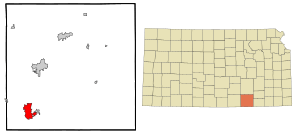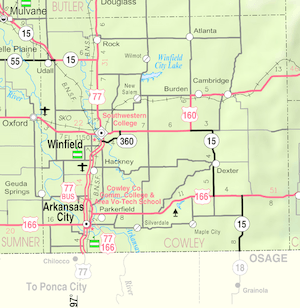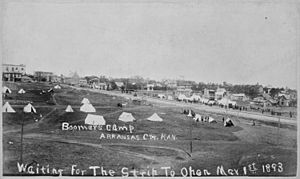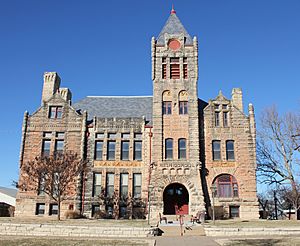Arkansas City, Kansas facts for kids
Quick facts for kids
Arkansas City, Kansas
|
|
|---|---|

Summit Avenue looking north (2013)
|
|
| Nickname(s):
Ark City
|
|

Location within Cowley County and Kansas
|
|

|
|
| Country | United States |
| State | Kansas |
| County | Cowley |
| Founded | 1870 |
| Incorporated | 1884 |
| Area | |
| • Total | 9.34 sq mi (24.18 km2) |
| • Land | 9.32 sq mi (24.13 km2) |
| • Water | 0.02 sq mi (0.05 km2) 0.21% |
| Elevation | 1,086 ft (331 m) |
| Population
(2020)
|
|
| • Total | 11,974 |
| • Density | 1,282.0/sq mi (495.20/km2) |
| Time zone | UTC-6 (CST) |
| • Summer (DST) | UTC-5 (CDT) |
| ZIP code |
67005
|
| Area code | 620 |
| FIPS code | 20-02300 |
| GNIS ID | 485541 |
Arkansas City (pronounced /ɑːrˈkænzəs/) is a city in Cowley County, Kansas, United States. It's located where the Arkansas River and Walnut River meet. In 2020, about 11,974 people lived there.
Contents
How to Say "Arkansas City"
The name of this city is said differently from the state of Arkansas. For the city, you say /ɑːrˈkænzəs/, which rhymes with "Kansas." The "s" at the end is pronounced.
Many people in Kansas also say the Arkansas River this way. The city is often called "Ark City" for short.
History of Arkansas City
Early History: Ancient City of Etzanoa
Long ago, the area where Arkansas City is now was home to a large Wichita city called Etzanoa. This city thrived between 1450 and 1700 and may have had as many as 20,000 people.
In 1601, a Spanish explorer named Juan de Oñate traveled through the Great Plains. He found a big group of Native Americans he called Rayados living along the Walnut River. These Rayados were the ancestors of the Wichita people.
19th Century: Settlers and Growth
European-American settlers started arriving in the Arkansas City area in the 1860s. The town was officially started in 1870. It had a few different names, like Adelphia and Walnut City, before "Arkansas City" was chosen. The first post office opened in 1870.
In 1877, a railroad line was built to Arkansas City. This helped the town grow. By 1891, the population grew very quickly. Thousands of people moved there, hoping to get land in the upcoming Cherokee Strip Land Run.
20th Century: Boom, Change, and Challenges
Around 1900, Arkansas City was a busy place, almost as big as Wichita. It had many rail lines, an opera house, nice hotels, factories, and a strong farming economy.
There was a popular swimming spot called Paris Lake, which later became the Paris Park pool. For a time, African Americans used a separate swimming facility.
The city also had some industries, like the Kirkwood Wind Engine Company (a windmill maker) and the Kanotex Refining Company (an oil refinery).
In the 1920s, a group called the Ku Klux Klan was active in the area. However, the state took action, and most of these groups closed down by 1927.
In 1928, the city started its yearly fall festival called Arkalalah. This event still happens every October. It includes a queen, a carnival, food vendors, and a long parade. A retired Santa Fe steam train, number 2542, was placed in Wilson Park during the 1955 Arkalalah festival and is still there today.
By the 1980s, Arkansas City faced some economic problems. Railroads moved their crews, and some large businesses closed. For example, the Binney & Smith (Crayola) plant closed in 2003.
21st Century: New Growth and Future Plans
Today, Arkansas City is home to Creekstone Farms Premium Beef LLC, a large meat processing company that employs over 1,100 people. Other smaller companies are also growing.
In 2006, a new hospital was planned and opened in March 2011. The city also saw the construction of the Keystone-Cushing Pipeline in 2010.
There are also ideas to bring back Amtrak passenger train service to Arkansas City, connecting it to Oklahoma City and Wichita.
Geography of Arkansas City
Arkansas City is located on the north side of the Arkansas River, just west of where it meets the Walnut River. It's near the junction of U.S. Route 77 and U.S. Route 166. The city is only about four miles (6.4 km) north of the Kansas-Oklahoma border.
Winfield, the county seat, is about 13 miles (21 km) north. Arkansas City is about 54 miles (87 km) southeast of Wichita.
The city covers about 9.38 square miles (24.29 km2) of land and a small amount of water.
Climate
Arkansas City has a humid subtropical climate. This means it has hot, humid summers and winters that are generally mild to cool.
Population of Arkansas City
| Historical population | |||
|---|---|---|---|
| Census | Pop. | %± | |
| 1880 | 1,012 | — | |
| 1890 | 8,347 | 724.8% | |
| 1900 | 6,140 | −26.4% | |
| 1910 | 7,508 | 22.3% | |
| 1920 | 11,253 | 49.9% | |
| 1930 | 13,946 | 23.9% | |
| 1940 | 12,752 | −8.6% | |
| 1950 | 12,903 | 1.2% | |
| 1960 | 14,262 | 10.5% | |
| 1970 | 13,216 | −7.3% | |
| 1980 | 13,201 | −0.1% | |
| 1990 | 12,762 | −3.3% | |
| 2000 | 11,963 | −6.3% | |
| 2010 | 12,415 | 3.8% | |
| 2020 | 11,974 | −3.6% | |
| U.S. Decennial Census 2010-2020 |
|||
According to the 2020 United States census, Arkansas City had 11,974 people. There were 4,467 households and 2,762 families.
About 26.8% of the population was under 18 years old. The median age was 33.8 years.
Education in Arkansas City
The public schools in Arkansas City are part of the Arkansas City USD 470 school district.
The first school in Arkansas City was started in 1870 by Professor H. B. Norton in his home. The public school system began in 1872.
Cowley College is located in Arkansas City. It started in 1922 in the basement of Arkansas City High School. It offers many different majors and training programs. Cowley College also has other campuses in nearby cities like Wichita and Winfield.
Media in Arkansas City
If you want to know what's happening in Arkansas City, you can check out these local media sources:
- The Arkansas City Traveler (local newspaper)
- The Winfield Daily Courier (newspaper for nearby Winfield)
Radio
- KSOK, 1280 AM, plays Country music
- KAXR, 91.3 FM, plays Religious music
- KACY, 102.5 FM, plays Classic hits
- KYQQ, 106.5 FM, plays Spanish music
Notable People from Arkansas City
Many interesting people have connections to Arkansas City, including:
- Darren Daulton: A baseball player for the Philadelphia Phillies and Florida Marlins.
- Frank Davis: A journalist, poet, and activist.
- Robert Docking: A former Mayor of Arkansas City and Governor of Kansas.
- Robert Eaton: A well-known businessman in the automobile industry.
- Lionel Hollins: A former NBA basketball player and coach.
- Nila Mack: An actress, writer, and director known for the radio show Let's Pretend.
- Sara Sothern: An actress and the mother of famous actress Elizabeth Taylor.
See Also
 In Spanish: Arkansas City (Kansas) para niños
In Spanish: Arkansas City (Kansas) para niños



